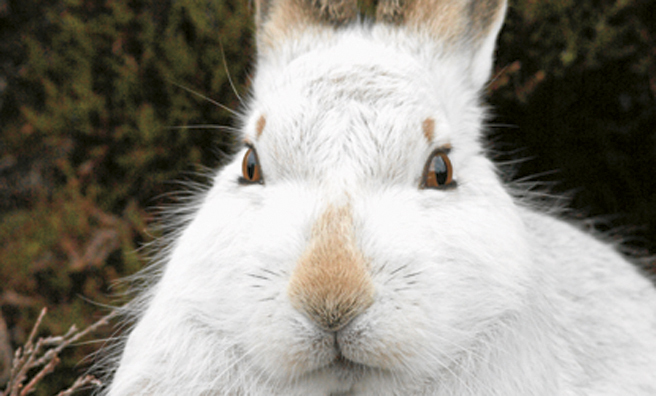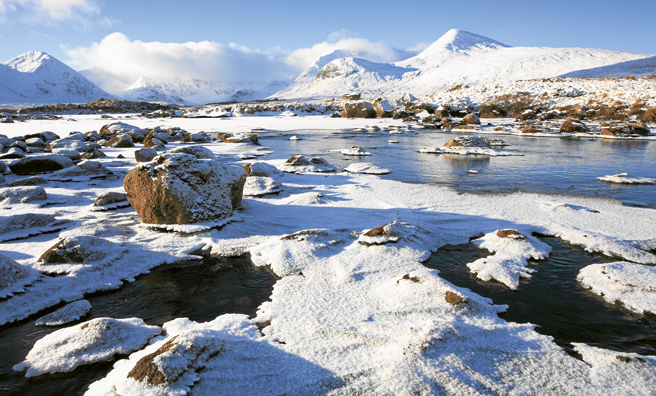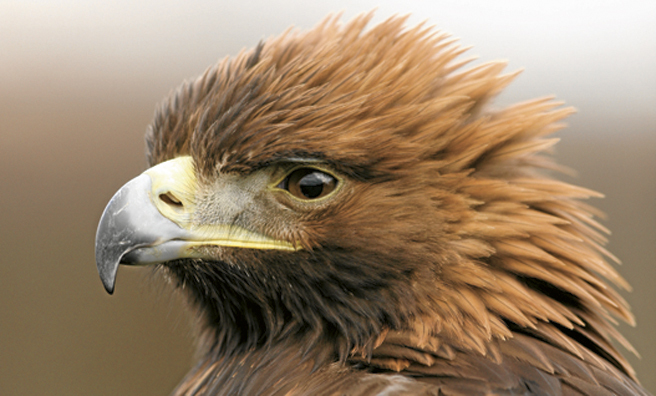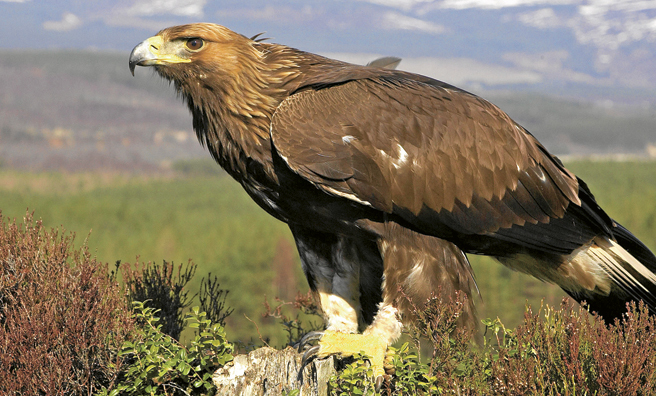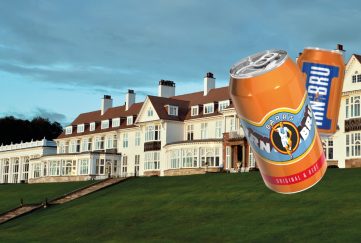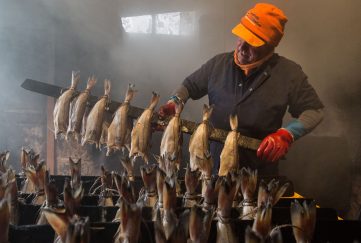Highland Stand-Off
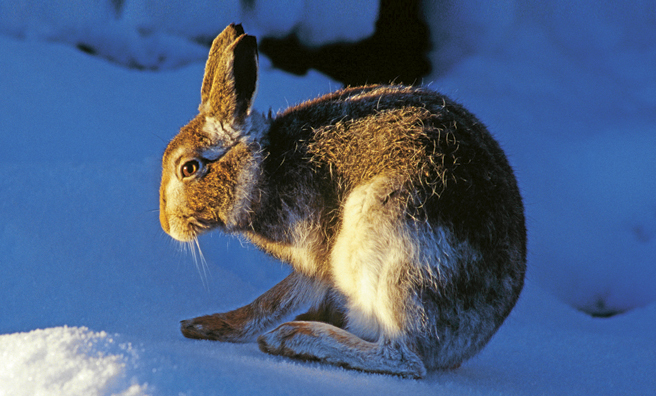
The wind is dry ice, the sky is pewter-grey and heavily pregnant with unborn snow. The dusk thickens too fast amid the old drifts that patch the hillside.
There is that edge of unease about the moment that stems from knowing I am running out of time before darkness falls or snow falls or both fall, and the distance to the road is a mile more than I would like it to be in the circumstances.
But the gloaming is my favourite hour in a situation like this, and my long stillness in the lee of a rock that wears a rakishly-canted Glengarry of frozen snow has just offered up the first hint of a reward. A golden eagle has just dropped over the skyline from a leisurely and level exploration of this portion of the broad-backed ridge where I sit, and I have a hunch she might be back.
Somewhere up there are at least two mountain hares
Why? Because I am as sure as I can be that somewhere up there on the nearest of the old snowfields that measures perhaps a hundred yards by fifty, there are at least two mountain hares.
I saw them step from heather on to snow, then the eagle caught my eye and when I tried to find the hares again I couldn’t – but I am as sure as I can be that they are still somewhere on the snow, and the eagle’s lingering presence may have something to do with that. From the hares’ point of view there is no point in having a winter-white coat and standing upright among the tussocks like a newly painted milestone when there is an eagle in your portion of the sky. So I submerge the nagging matter of my own travel logistics and command my eyes to see deeper into the shallow white contours above me.
This is the oldest stand-off in the Highlands, the mountain hare and the golden eagle, both among the very earliest presences in the landscape, one the favourite prey of the other, one trying to outwit the other with stillness and sheer nerve, while the most accomplished pair of wings and the best seeing eyes in my portion of the wild world conspire in a single, simple purpose: to see through the stillness and terrify the hare into reckless panic.
I scour the old snow, wishing I knew what the eagle was looking for
Without eagle eyes, but with a very good pair of German binoculars, I scour the old snow, wishing I knew what the eagle was looking for, how to isolate the different texture and the different shade and quality of hare whiteness from snow whiteness. There again, if the hares are hunkered down behind that shallow fold that runs diagonally across the snow from top right to bottom left, I won’t be seeing them unless they move. The eagle, on the other hand, has just sidled back over the skyline as slow as a slug, and begins to head towards the upward edge of the snow.
She flies on still wings a yard above the ground. Does she see them yet? Or is she counting on the very menace of her presence to persuade the hares to betray themselves?
Commonsense tells me it won’t happen
Then there is a moment in which her flight is aligned directly with my rock, and apparently looking straight at me and flying at an altitude that could bring her talons into direct contact with me about halfway up my head. Commonsense tells me it won’t happen, but there is that moment when I borrow briefly from the hare’s ancient awareness of itself as an eagle’s quarry. I swallow it down despite my relentlessly determined stillness.
The eagle banks sideways a hundred yards away. I am not dressed in mountain-hare white and even in my hill-coloured stillness, she sees me for what I am and wants no part of it. She wheels uphill on two wingbeats and recrosses the skyline. If she returns, it will be when I have gone.
Something tells me my time is up. That was my moment; no denouement, but so beautiful in its setting and its suppressed tension that I feel fulfilled by it. I rise and turn away downhill, and lift my face to the sky in a wordless “thank you” to who knows what. A single snowflake blinks into an eye. Another trembles on the back of my glove. I pick up the pace.
The encounter I have just described was four Decembers ago and I have not seen one since then
And now I have a question for you. When was the last time you saw a mountain hare? I am asking because the encounter I have just described was four Decembers ago and I have not seen one since then.
Yet something like twenty winters ago and on this same hill, I saw more than thirty mountain hares explode from an old snowfield in similar circumstances, an eagle leaning against the wind.
People I know who are out on the hill a lot say the same thing: no mountain hares where there used to be many, and you would even find their roadkill remains by quiet roadside verges. It is not a new situation, it is not as if no-one knows about it; it is just that no-one seems to know the extent of the problem and no-one is doing anything about it.
Questions were even asked in the Scottish Parliament in 2013. Mid Scotland and Fife MSP Claire Baker put a series of questions about culling mountain hares to environment minister Paul Wheelhouse.
The answers were not all that one might have hoped for. In summary, the reasons mountain hares are shot are for tick control (yet another manifestation of the obsessive management of grouse moors), for “sporting purposes” (killing for the sake of killing, and killing to make money; we don’t eat hare in 21st century Scotland, but Italians have been known to fill refrigerated vans with Scottish mountain hares and take them home).
The mountain hare as a feller of forests takes some swallowing
And mountain hares are snared, said Mr Wheelhouse “for the purposes of tick control or for the protection of crops or forests”. Hmm, the mountain hare as a feller of forests takes some swallowing.
Then there is the question of numbers. No-one knows how many are shot each year, although in 2006 a Scottish Natural Heritage report on the control of mountain hares on Scottish estates produced a figure of 24,529. Worse, no-one knows how many mountain hares there are. Mr Wheelhouse conceded that the only published information was from 1995 when an estimate of 350,000 “is subject to a 50 per cent margin of error”.
We are sleep-walking towards its extinction
The arithmetic is terrifying. Even eighteen years ago, the population was perhaps as low as 175,000, and if the 2006 cull was anything like average and the estates have been taking out 25,000 each year, then the mountain hare is on the wrong end of an irresistible momentum. We are sleep-walking towards its extinction.
Nothing would please the grouse moor fraternity more, of course, because of its conviction that mountain hares transmit ticks to grouse, despite the complete absence of scientific evidence. In fact the most recent study by the Journal of Applied Ecology in 2009 concluded that “there is no compelling evidence that culling hares might increase red grouse density”.
On the other hand, the RSPB points out that golden eagles prey on mountain hares and hen harriers prey on leverets, and you would think it would be in the interests of grouse moor managers to ensure that there was something else other than grouse for predators to eat. But then this is an industry that is so paranoid about ticks that it has taken to putting out boxes of medicated grit for grouse to ingest, so logic does not appear to be its strong suit.
The mountain hare is one of Scotland’s oldest species
How does it come to this? How do we account for a failure of this magnitude in our stewardship of the landscape?
The mountain hare is one of Scotland’s oldest species, and one that has been entwined in our own folklore for thousands of years. Yet now, even as we profess to understand the worth of conservation, it stands on the edge of the abyss because a minority interest in the countryside obsesses endlessly about ticks on a grouse?
It seems that we have reached a nadir in our relationship with the land, that nothing in the landscape is sacred including the landscape itself. Right now we are losing the wildcat, the capercaillie, the mountain hare, the hen harrier, we have wasted millions on a trial beaver reintroduction in Argyll while the beavers in Tayside have demonstrated how easy it is and it need cost nothing at all. Meanwhile we put down medicated grit for grouse and call it conservation.
Scotland should be a safe haven for nature. The diversity of our landscape and of natural habitats is outstanding, its potential all but limitless, but every passing season erodes and diminishes it in the name of our own self-interest.
The mountain hare is simply the latest visible symptom of a phenomenon that has been going on since we eradicated the wolf.
The new, unacceptable truth that you are faced with is this: the last time you saw a mountain hare may well prove to be the last time you see a mountain hare.
- A close-up of a mountain hare in its white winter pelage – ears remain brown
- Perfect camouflage for mountain hares
- Eagle eyes – a hare’s worst nightmare
- The golden eagle is one of Jim Crumley’s favourite species
- A mountain hare with intermediate coat
Mountain hare facts
- A hare’s diet is predominantly heather and grasses
- Once abundant, the mountain hare is now a rare sight in Scotland
- A young mountain hare is called a leveret. The females are called “doe” or “jill” and males “buck” or “jack”.
- A mountain hare group is called a band or down


